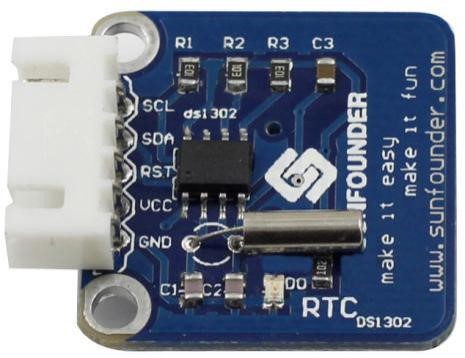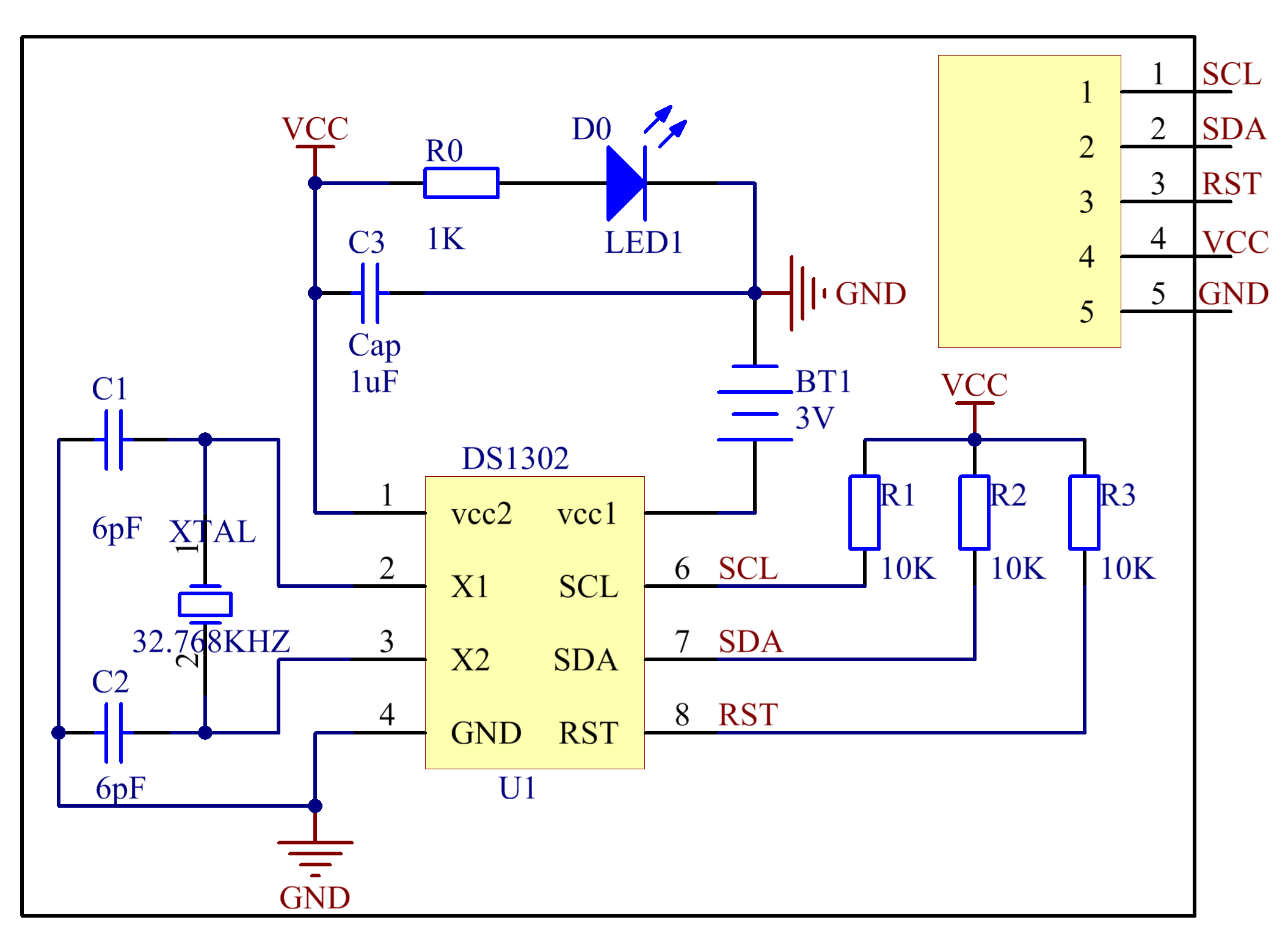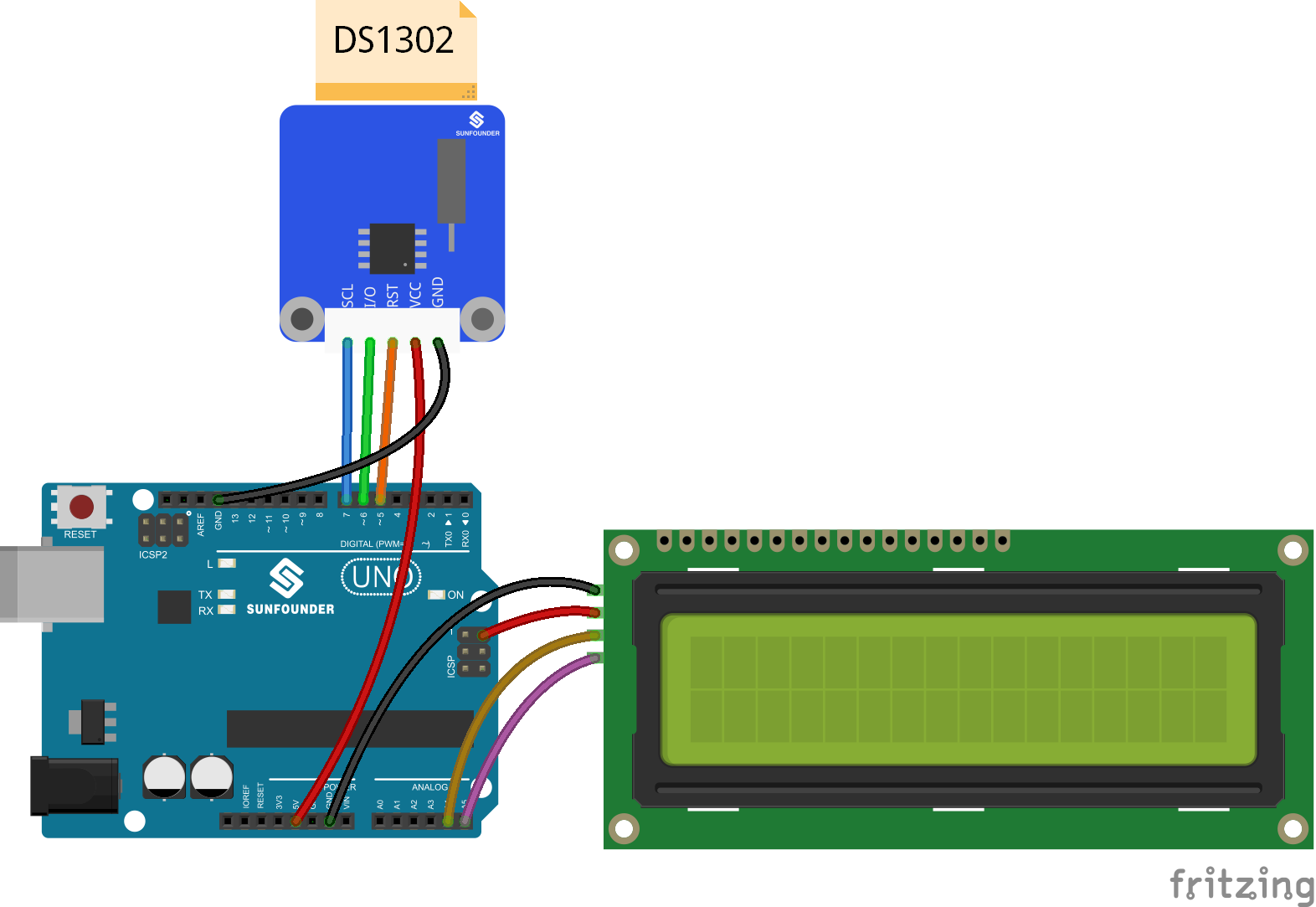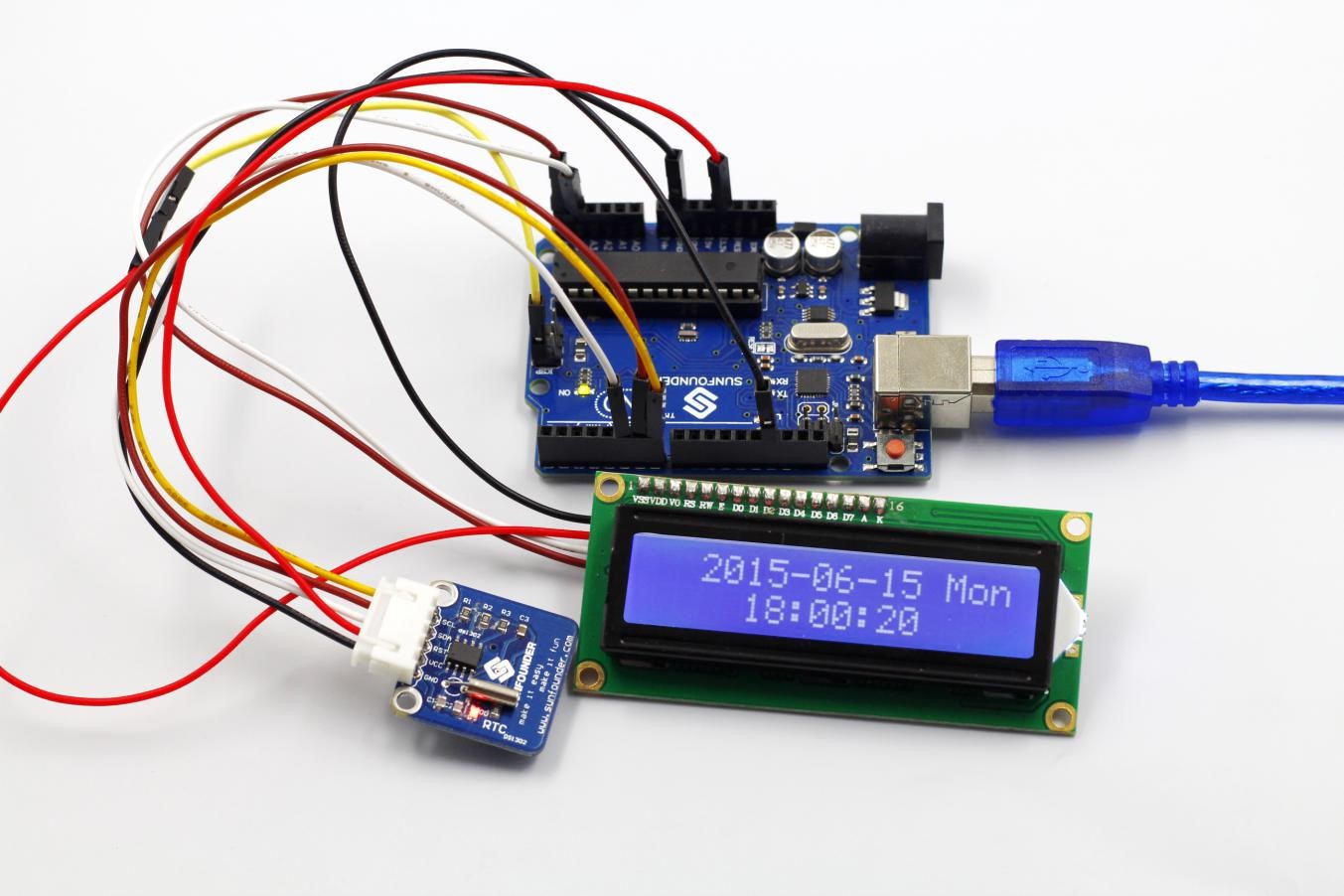Introduction
Nowadays there are many popular serial clock circuits such as DS1302, DS1307, PCF8485, etc. They are widely used for simple interface, low cost, and ease of use. In this lesson, we will use the DS1302 real-time clock (RTC) module to obtain current date and time.

Components
– 1 * SunFounder Uno board
– 1 * USB data cable
– 1 * RTC-DS1302 module
– 1 * I2C LCD1602 module
– 1 * 5-Pin anti-reverse cable
– 1 * 4-Pin anti-reverse cable
– 1 * Dupont wire (F to F)
Experimental Principle
DS1302 is a trickle charging clock chip, launched by DALLAS in America. With a built-in real-time clock/calendar and a 31-byte static RAM, it can communicate with MCU through simple serial ports. The real-time clock/calendar circuit provides information about second, minute, hour, day, week, month, and year. DS1302 can automatically adjust the number of days per month and days in leap year. You can determine to use a 24-hour or 12-hour system by AM/PM selection. It can simply communicate with MCU in synchronous serial way and only needs to use three port cables: Reset (RST) cable, I/O data (SDA) cable and serial clock (SCL) cable.
The schematic diagram of the module:

Experimental Procedures
Step 1: Build the circuit
The wiring between DS1302 and SunFounder Uno board is as shown below:
| DS1302 | SunFounder Uno |
| SCL | 7 |
| SDA | 6 |
| RST | 5 |
| VCC | 3.3V |
| GND | GND |

Step 2: Program (Please refer to the example code in LEARN -> Get Tutorial on our website)
Note: Here you need to add a library. Refer to the description in Lesson 1 previously in the manual.
Step 3: Compile
Step 4: Upload the sketch to SunFounder Uno board
Now, you can see the current date and time information displayed on the I2C LCD1602.

Code
| /***************************************************** * name:Real-time Clock Module * function:you can see the current date and time displayed on the I2C LCD1602. ******************************************************/ //Email:support@sunfounder.com //Website:www.sunfounder.com//include the libraries #include <stdio.h> #include <string.h> #include <DS1302.h> #include <Wire.h> #include <LiquidCrystal_I2C.h>LiquidCrystal_I2C lcd(0x27,16,2); // set the LCD address to 0x27 for a 16 chars and 2 line displayuint8_t RST_PIN = 5; //RST pin attach to uint8_t SDA_PIN = 6; //IO pin attach to uint8_t SCL_PIN = 7; //clk Pin attach to /* Create buffers */ char buf[50]; char day[10];String comdata = “”; int numdata[7] ={ 0}, j = 0, mark = 0; /* Create a DS1302 object */ DS1302 rtc(RST_PIN, SDA_PIN, SCL_PIN);//create a variable type of DS1302 void print_time() { /* Get the current time and date from the chip */ Time t = rtc.time(); /* Name the day of the week */ memset(day, 0, sizeof(day)); switch (t.day) { case 1: strcpy(day, “Sun”); break; case 2: strcpy(day, “Mon”); break; case 3: strcpy(day, “Tue”); break; case 4: strcpy(day, “Wed”); break; case 5: strcpy(day, “Thu”); break; case 6: strcpy(day, “Fri”); break; case 7: strcpy(day, “Sat”); break; } /* Format the time and date and insert into the temporary buffer */ snprintf(buf, sizeof(buf), “%s %04d-%02d-%02d %02d:%02d:%02d”, day, t.yr, t.mon, t.date, t.hr, t.min, t.sec); /* Print the formatted string to serial so we can see the time */ Serial.println(buf); lcd.setCursor(2,0); lcd.print(t.yr); lcd.print(“-“); lcd.print(t.mon/10); lcd.print(t.mon%10); lcd.print(“-“); lcd.print(t.date/10); lcd.print(t.date%10); lcd.print(” “); lcd.print(day); lcd.setCursor(4,1); lcd.print(t.hr); lcd.print(“:”); lcd.print(t.min/10); lcd.print(t.min%10); lcd.print(“:”); lcd.print(t.sec/10); lcd.print(t.sec%10); } void setup() { Serial.begin(9600); rtc.write_protect(false); rtc.halt(false); lcd.init(); //initialize the lcd lcd.backlight(); //open the backlight Time t(2015, 6, 15, 17, 59, 50, 2);//initialize the time /* Set the time and date on the chip */ rtc.time(t); }void loop() { /*add the data to comdata when the serial has data */ while (Serial.available() > 0) { comdata += char(Serial.read()); delay(2); mark = 1; } /* Use a comma to separate the strings of comdata, and then convert the results into numbers to be saved in the array numdata[] */ if(mark == 1) { Serial.print(“You inputed : “); Serial.println(comdata); for(int i = 0; i < comdata.length() ; i++) { if(comdata[i] == ‘,’ || comdata[i] == 0x10 || comdata[i] == 0x13) { j++; } else { numdata[j] = numdata[j] * 10 + (comdata[i] – ‘0’); } } /* The converted numdata add up to the time format, then write to DS1302*/ Time t(numdata[0], numdata[1], numdata[2], numdata[3], numdata[4], numdata[5], numdata[6]); rtc.time(t); mark = 0; j=0; /* clear comdata ,in order to wait for the next input */ comdata = String(“”); /* clear numdata */ for(int i = 0; i < 7 ; i++) numdata[i]=0; } /* print the current time */ print_time(); delay(1000); } |
